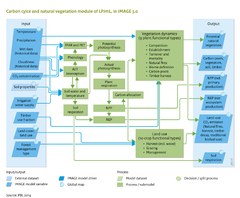Carbon cycle and natural vegetation/Description: Difference between revisions
Jump to navigation
Jump to search
No edit summary |
No edit summary |
||
| Line 1: | Line 1: | ||
{{ComponentDescriptionTemplate | {{ComponentDescriptionTemplate | ||
|Reference=Prentice et al., 2007; Lauk et al., 2012; Klein Goldewijk et al., 2011; | |Reference=Prentice et al., 2007; Lauk et al., 2012; Klein Goldewijk et al., 2011; | ||
|Description=<h3>Vegetation types</h3> | |Description=<h3>Vegetation types</h3> | ||
LPJmL is a Dynamic Global Vegetation Model ({{abbrTemplate|DGVM}}) that was developed initially to assess the role of the terrestrial biosphere in the global carbon cycle ([[Prentice et al., 2007]]). DGVMs simulate vegetation distribution and dynamics, using the concept of multiple plant functional types ({{abbrTemplate|PFT}}s) differentiated according to their bioclimatic (e.g. temperature requirement), physiological, morphological, and phenological (e.g. growing season) attributes, and competition for resources (light and water). | LPJmL is a Dynamic Global Vegetation Model ({{abbrTemplate|DGVM}}) that was developed initially to assess the role of the terrestrial biosphere in the global carbon cycle ([[Prentice et al., 2007]]). DGVMs simulate vegetation distribution and dynamics, using the concept of multiple plant functional types ({{abbrTemplate|PFT}}s) differentiated according to their bioclimatic (e.g. temperature requirement), physiological, morphological, and phenological (e.g. growing season) attributes, and competition for resources (light and water). | ||
| Line 23: | Line 23: | ||
===Model linkage and simulation procedure=== | ===Model linkage and simulation procedure=== | ||
The [[LPJmL model]] has multiple links to other IMAGE components and uses IMAGE data on climate, atmospheric CO2 concentration, land use (including wood demand), and timber use and deforestation (cutting and burning). LPJmL supplies other IMAGE components with information on annual carbon fluxes, net CO2 exchange between biosphere and atmosphere, size of carbon pools, and biome classes (see [[Carbon_cycle_and_natural_vegetation| | The [[LPJmL model]] has multiple links to other IMAGE components and uses IMAGE data on climate, atmospheric CO2 concentration, land use (including wood demand), and timber use and deforestation (cutting and burning). LPJmL supplies other IMAGE components with information on annual carbon fluxes, net CO2 exchange between biosphere and atmosphere, size of carbon pools, and biome classes (see [[Carbon_cycle_and_natural_vegetation|Input/output Table]] at Introduction part ). | ||
LPJmL and IMAGE are linked via an interface and starts in the simulation year of 1970. Before 1970, vegetation and soil carbon pools need to be initialised. This is done by using LPJmL first in a 1000-year spin up to initialise the natural ecosystems and their carbon pools and fluxes, followed by a 390-year spin up, in which agricultural land is gradually expanded based on historical [[HYDE database|HYDE]] land-use data ([[Klein Goldewijk et al., 2011]]). The pool sizes of timber products for 1970 are based on literature estimates ([[Lauk et al., 2012]]). | LPJmL and IMAGE are linked via an interface and starts in the simulation year of 1970. Before 1970, vegetation and soil carbon pools need to be initialised. This is done by using LPJmL first in a 1000-year spin up to initialise the natural ecosystems and their carbon pools and fluxes, followed by a 390-year spin up, in which agricultural land is gradually expanded based on historical [[HYDE database|HYDE]] land-use data ([[Klein Goldewijk et al., 2011]]). The pool sizes of timber products for 1970 are based on literature estimates ([[Lauk et al., 2012]]). | ||
Revision as of 11:22, 20 May 2014
Parts of Carbon cycle and natural vegetation/Description
| Component is implemented in: |
|
| Related IMAGE components |
| Models/Databases |
| Key publications |
| References |
